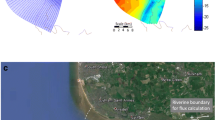Abstract
A new model of bioturbation has been developed to describe short term sediment reworking induced by macrobenthic communities. The design of the model had to consider the mixing processes, firstly, at the organism level, and secondly, at community level. This paper describes the mixing mode of the four types of bioturbators defined by the authors: the biodiffusors, the upward-conveyors, the downward-conveyors and the regenerators. The mathematical formulation of these sub-models consists of ordinary differential equations. They take into account the size of the bioturbated zone, the output fluxes to the water column, tracer decay, physical mixing due to local currents and the type and intensity of the bioturbation processes. These sub-models make it possible to describe correctly the mixing events that have occurred in cores with each type of bioturbator. They also provide the basis for general bioturbation model, that will take into account the respective degrees of involvement of (i) the different bioturbation processes and their characteristics, (ii) the interference between the different processes, and (iii) make possible to predict the particle reworking in order to include it in studies of organic matter in early diagenesis.
Similar content being viewed by others
REFERENCES
Aller, R.C. and J.K. Cochran (1976). 234Th/238U disequilibrium in near-shore scdiment: particle reworking and diagenetic time scales. Earth Planet. Sc. Lett. 29: 37–50.
Aller, R.C. (1982). The effects of macrobenthos on chemical properties of marine sediment and overlying water. In: P.L. McCall and M.J.S. Tevest, eds. Animal-Sediment Relations, pp. 53–102. New York, Plenum.
Aller, R.C. and D.J. De Master (1984). Estimates of particle flux and reworking at the deep-sea floor using 234Th/238U desequilibrium. Earth Planet. Sc. Lett. 67: 308–318.
Benninger, L.K., R.C. Aller, J.K. Cochran and K.K. Turckian (1979). Effects of biological sediment mixing on the 210Pb chronology and trace metal distribution in a Long Island Sound sediment core. Earth Planet. Sc. Lett. 43: 241–259.
Berger, W.H. and G.R. Heath (1969). Vertical mixing in pelagic sediment. J. mar. Res. 26: 134–143.
Boudreau, B.P. (1986). Mathematics of tracer mixing in sediment. I-Spatially-dependent, diffusive mixing. II: Non local mixing and biological conveyor-belt phenomena. Am. J. Sc. 286: 161–238.
Christensen, E.R. (1982). A model for radionuclides in sediments influenced by mixing and compaction. J. Geophys. Res. 87: 566–572.
Cochran, J.K. (1985). Particle mixing rates in sediments of the eastern equatorial Pacific: Evidence from 210Pb, 239, 240Pu and 137Cs distribution at MANOP sites. Geochim. Cosmochim. Acta 49: 1195–1210.
Demailly, J.P. (1991). Analyse Numérique et Equations Différentielles. Presses Universitaires de Grenoble.
Fisher, J.B., W.L. Lick, P.L. McCall, and J.A. Robbins (1980). Vertical mixing of lake sediments by tubiticid oligochaetes. J. Geophys. Res. 85: 3997–4006.
Foster, D.W. (1985). Bioturb: a fortran program to simulate the effects of bioturbation on the vertical distribution of sediment. Computers and Geosciences 11: 39–54.
Gardner, L.R., P. Sharma and W.S. Moore (1987). A regeneration model for the effect of bioturbation by fiddler crabs on 210Pb profiles in salt marsh sediments. J. Environ. Radioact. 5: 25–36.
Gerino, M. (1992). Etude expérimentale de la bioturbation en milieu littoral et profond. Quantification des structures de bioturbation et modélisation du remaniement biologique du sédiment. Thèse de Doctorat de I'Université Aix-Marseille II: 208 pp.
Gerino, M., G. Stora and J.P. Durbec (1994). Quantitative estimation of biodiffusive and bioadvective sediment mixing: In situ experimental approach. Oceanol. Acta 17: 547–554.
Goldberg, E.D. and M. Koide (1962). Geochronological studies of deep-sea sediments by the ionium/thorium method. Geochim. Cosmochim. Acta 26: 417–450.
Guinasso, N.L. and D.R. Schink (1975). Quantitative estimates of biological mixing rates in abyssal sediments. Geophys. Res. 80: 3032–3043.
Lee, H. and C. Swartz (1980) Biological processes affecting the distribution of pollutants in marine sediments. II-Biodeposition and bioturbation. In: R.A. Baker, ed. Contaminants and Sediments 2, pp. 555–606. Ann. Arbor. Sciences Publ.
Li, W.Q., N.L. Guinasso, K.H. Cote, M.D. Richardson, J.W. Johnson and D.R. Schink (1985). Radionucleides as indicators of sedimentary processes in abyssal caribbcan sediments. Mar. Ecol. 68: 187–204.
Reynoldson, T.B. (1987). Interaction between sediment contaminants and benthic organisms. Hydrobiologia 149: 53–66.
Rhoads, D.C. (1974). Organism-sediment relations on the muddy sea floor. Oceanogr. Mar. Biol. Ann. Rev. 12: 263–300.
Kobbins, J.A., P.L. Mc Call, J.B. Fisher and J.R. Krezoski (1979). Effects of deposit feeders on migration of 137Cs in lake sediments. Earth Planet. Sc. Lett. 42: 277–287.
Salomons, W., N.M. De Rooij, H. Kerdijk and J. Bril (1987). Sediments as a source for contaminants? Hydrobiologia 149: 13–30.
Schink, D.R. and N.L. Guinasso (1977). Effects of bioturbation on sediment-sea water interaction. Mar. Geol. 23: 133–154.
Smith, C.R., P.A. Jumars and D.J. De Master (1986). In situ studies of megafaunal mounds indicate rapid sediment turnover and community response at the deep-sea floor. Nature 323(6085): 251–253.
Smith, J.N., B.P. Boudreau and V. Noshkin (1986/1987). Plutonium and 210Pb distributions in NortheastAtlantic scdiments subsurface anomalies caused by non local mixing. Earth Planet. Sc. Lett. 28: 15–28.
Stordal, M.C., J.W. Johnson, N.L. Guinasso and D.R. Schink (1985). Quantitative evaluation of bioturbation rates in deep ocean sediments. II Comparison of rates determined by 210Pb and 239/240Pu. Mar. Chem. 17: 99–114.
Wheatcroft, R.A., P.A. Jumars, C.R. Smith, and A.R.M. Nowell (1990). A mechanistic view of the particulate biodiffusion coefficient: Step lengths, rest periods and transport directions. J. Mar. Res. 48: 177–207.
Yokoyama, Y., H.V. Nguyen, C.E. Lambert and R. Chesselet (1985). Etude de la bioturbation dans les sédiments superficiels de la Méditerranée occidentale par le traceur 210Pb. Oceanol. Acta 8: 285–291.
Author information
Authors and Affiliations
Rights and permissions
About this article
Cite this article
François, F., Poggiale, JC., Durbec, JP. et al. A New Approach for the Modelling of Sediment Reworking Induced by a Macrobenthic Community. Acta Biotheor 45, 295–319 (1997). https://doi.org/10.1023/A:1000636109604
Issue Date:
DOI: https://doi.org/10.1023/A:1000636109604




